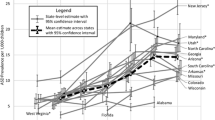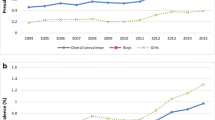Abstract
This study examined changes in the administrative prevalence of autism spectrum disorders (ASD) in Utah children from 2002 to 2008 by record source (school and health), age (four, six, and eight), and special education classification. Prevalence increased 100% with 1 in 77 children aged eight identified with ASD by 2008. Across study years and age groups rates were higher when health and school data were combined with a greater proportion of cases ascertained from health. The proportion of children with both a health ASD diagnosis and a special education autism classification did not significantly change. Most children with an ASD health diagnosis did not have an autism special education classification. Findings highlight the growing health and educational impact of ASD.


Similar content being viewed by others
References
U.S. Census Bureau. (2009). 2009 American community survey. Table R1105. Retrieved October 15, 2010, from http://factfinder.census.gov/home/saff/main.html?_lang=en.
American Psychiatric Association. (2000). Diagnostic criteria from DSM-IV-TR. Washington, D.C.: American Psychiatric Association.
American Psychiatric Association. (2010). DSM-5: The Furture of psychiatric diagnosis. Retrieved from https://www.dsm5.org/Pages/Default.aspx.
Avchen, R. N., Wiggins, L.D., Devine, O., Van Naarden Braun, K., Rice, C., Hobson, N. C., et al. (2010). Evaluation of a records-review surveillance system used to determine the prevalence of autism spectrum disorders. Journal of Autism and Developmental Disorders, 41(2), 227–236.
Baird, M. M. (1999). Legal issues in autism. In Proceedings of the 20th National Institute on Legal Issues of Educating Individuals with Disabilities. Alexandria, VA: LRP Publications.
Barbaresi, W. J., Katusic, S. K., Colligan, R. C., Weaver, A. L., & Jacobsen, S. J. (2005). The incidence of autism in Olmsted County, Minnesota, 1976–1997: Results from a population-based study. Archives of Pediatrics and Adolescent Medicine, 159(1), 37–44.
Bishop, D. V., Whitehouse, A. J., Watt, H. J., & Line, E. A. (2008). Autism and diagnostic substitution: evidence from a study of adults with a history of developmental language disorder. Developmental Medicine and Child Neurology, 50(5), 341–345.
Center for Special Education Finance. (2003). Total expenditures for students with disabilities, 1999–2000: Spending variation by disability. American Institutes for Research.
Centers for Disease Control and Prevention. (2007). Prevalence of autism spectrum disorders–autism and developmental disabilities monitoring network, 14 sites, United States, 2002. MMWR Surveillance summaries, 56(1), 12–28.
Centers for Disease Control and Prevention. (2009). Prevalence of autism spectrum disorders—autism and developmental disabilities monitoring network, United States, 2006. MMWR Surveillance summaries, 58(10), 1–20.
Fombonne, E. (2001). Is there an epidemic of autism? Pediatrics, 107(2), 411–412.
Fombonne, E. (2009). Epidemiology of pervasive developmental disorders. Pediatric Research, 65(6), 591–598.
Fombonne, E., Heavey, L., Smeeth, L., Rodrigues, L. C., Cook, C., Smith, P. G., et al. (2004). Validation of the diagnosis of autism in general practitioner records. BMC Public Health, 4, 5.
Fombonne, E., Zakarian, R., Bennett, A., Meng, L., & McLean-Heywood, D. (2006). Pervasive developmental disorders in Montreal, Quebec, Canada: Prevalence and links with immunizations. Pediatrics, 118(1), e139–e150.
Governor’s Office of Planning and Budget. (2001). Top ten Utah census 2000. Retrieved October 18, 2010, from http://governor.utah.gov/dea/Census2000Data/TopTen.PDF.
Grether, J. K., Rosen, N. J., Smith, K. S., & Croen, L. A. (2009). Investigation of shifts in autism reporting in the California department of developmental services. Journal of Autism and Developmental Disorders, 39(10), 1412–1419.
Gurney, J. G., Fritz, M. S., Ness, K. K., Sievers, P., Newschaffer, C. J., & Shapiro, E. G. (2003). Analysis of prevalence trends of autism spectrum disorder in Minnesota. Archives of Pediatrics and Adolescent Medicine, 157(7), 622–627.
Hamilton, B. E., Martin, J. A., & Ventura, S. J. (2009). Utah has the country’s highest fertility rate in the country. National vital statistics reports 57 (7). Retrieved January 20, 2010, from http://www.cdc.gov/nchs/data/nvsr/nvsr57/nvsr57_12.pdf.
International Classification of Diseases. (1988). Clinical modifications (9th ed.). Washington, DC: Public Health Service.
Kielinen, M., Linna, S. L., & Moilanen, I. (2000). Autism in Northern Finland. European Child and Adolescent Psychiatry, 9(3), 162–167.
King, M., & Bearman, P. (2009). Diagnostic change and the increased prevalence of autism. International Journal of Epidemiology, 38(5), 1224–1234.
Kogan, M. D., Blumberg, S. J., Schieve, L. A., Boyle, C. A., Perrin, J. M., Ghandour, R. M., et al. (2009). Prevalence of parent-reported diagnosis of autism spectrum disorder among children in the US, 2007. Pediatrics, 124(5), 1395–1403.
Laidler, J. R. (2005). US Department of Education data on “autism” are not reliable for tracking autism prevalence. Pediatrics, 116(1), e120–e124.
Lauritsen, M., Jorgensen, M., Madsen, K., Lemcke, S., Toft, S., Grove, J., et al. (2010). Validity of childhood autism in the Danish psychiatric central register: Findings from a chorot sample born 1990–1999. Journal of Autism and Developmental Disorders, 40(2), 139–148.
MacFarlane, J. R., & Kanaya, T. (2009). What does it mean to be autistic? Inter-state variation in special education criteria for autism services. Journal of Child and Family Studies, 18(6), 662–669.
Nassar, N., Dixon, G., Bourke, J., Bower, C., Glasson, E., de Klerk, N., et al. (2009). Autism spectrum disorders in young children: Effect of changes in diagnostic practices. International Journal of Epidemiology, 38(5), 1245–1254.
National Archives and Records Administration. (2010). Code of federal regulations. Retrieved from http://www.access.gpo.gov/cgi-bin/cfrassemble.cgi?title=200034.
Newschaffer, C. J., Falb, M. D., & Gurney, J. G. (2005). National autism prevalence trends from United States special education data. Pediatrics, 115(3), e277–e282.
Office of Special Education Programs. (2008). Part B –trend data report for states and outlying areas, 2003-04 through 2007-08. Retrieved from https://www.ideadata.org/default.asp.
Office of Special Education Programs. (2008). Profiles of parts b and c programs in states and outlying areas. Retrieved from https://www.ideadata.org/default.asp.
Pinborough-Zimmerman, J., Bilder, D., Satterfield, R., Hossain, S., & McMahon, W. (2010). The impact of surveillance method and record source on autism prevalence: collaboration with Utah maternal and child health programs. Maternal and Child Health Journal, 14(3), 392–400.
SAS Institute. (2008). SAS version 9.2. Cary North Carolina, USA: SAS Institute.
Shattuck, P. T. (2006). Diagnostic substitution and changing autism prevalence. Pediatrics, 117(4), 1438–1439.
Utah Department of Health. (2010). Center for health data, indicator-based information system for public health. Retrieved September 1, 2010, from http://ibis.helath.utah.gov.
Utah State Board of Education. (2010). Special education rules. Retrieved October 18, 2010, from http://www.schools.utah.gov/sars/DOCS/law/finalrules.aspx.
Van Naarden Braun, K., Pettygrove, S., Daniels, J., Miller, L., Nicholas, J., Baio, J., et al. (2007). Evaluation of a methodology for a collaborative multiple source surveillance network for autism spectrum disorders–autism and developmental disabilities monitoring network, 14 sites, United States, 2002. MMWR Surveillance summaries, 56(1), 29–40.
Yeargin-Allsopp, M., Rice, C., Karapurkar, T., Doernberg, N., Boyle, C., & Murphy, C. (2003). Prevalence of autism in a US metropolitan area. The journal of the American Medical Association, 289(1), 49–55.
Acknowledgments
This work was partially supported by funding from the Utah Department of Health and Utah State Office of Education. Special thanks to Marc Babitz, Paul Carbone, Nan Gray, Harper Randall, Robert Satterfield and Nan Streeter.
Author information
Authors and Affiliations
Corresponding author
Rights and permissions
About this article
Cite this article
Pinborough-Zimmerman, J., Bakian, A.V., Fombonne, E. et al. Changes in the Administrative Prevalence of Autism Spectrum Disorders: Contribution of Special Education and Health from 2002–2008. J Autism Dev Disord 42, 521–530 (2012). https://doi.org/10.1007/s10803-011-1265-2
Published:
Issue Date:
DOI: https://doi.org/10.1007/s10803-011-1265-2




